
Mecklenburg-Vorpommern, also known by its anglicized name Mecklenburg–Western Pomerania, is a state in the north-east of Germany. Of the country's sixteen states, Mecklenburg-Vorpommern ranks 14th in population; it covers an area of 23,300 km2 (9,000 sq mi), making it the sixth largest German state in area; and it is 16th in population density. Schwerin is the state capital and Rostock is the largest city. Other major cities include Neubrandenburg, Stralsund, Greifswald, Wismar, and Güstrow. It was named after the two regions of Mecklenburg and Fore Pomerania.

Ludwigslust is a former Kreis (district) in the southwest of Mecklenburg-Vorpommern, Germany. Neighboring districts were Nordwestmecklenburg, the district-free city Schwerin, Parchim, Prignitz in Brandenburg, Lüchow-Dannenberg and Lüneburg in Lower Saxony and the district Lauenburg in Schleswig-Holstein. The district was disbanded at the district reform of September 2011. Its territory has been part of the Ludwigslust-Parchim district since.

Ludwigslust is a central castle town of Mecklenburg-Vorpommern, Germany, 40 km south of Schwerin. Since 2011 it has been part of the Ludwigslust-Parchim district.

Cambs is a municipality in the Ludwigslust-Parchim district, in Mecklenburg-Vorpommern, Germany.

Hagenow is a German town in the southwest of Mecklenburg-Western Pomerania, in the district of Ludwigslust-Parchim, 30 kilometers south of Schwerin. Its population is approximately 11,300 inhabitants (2013).
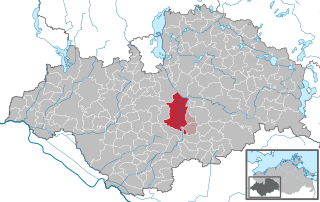
Neustadt-Glewe is a German town, in Mecklenburg-Western Pomerania, in the district of Ludwigslust-Parchim.

Bresegard bei Picher is a small municipality in the German state of Mecklenburg-Vorpommern. Often it is simply referred to simply as Bresegard. There is another municipality within Mecklenburg also called Bresegard and to differentiate the two 'bei Picher' is added, signifying a close proximity to the town of Picher. The other Bresegard is near the town of Eldena and is called Bresegard bei Eldena. Bresegard bei Picher, part of the Amt of Hagenow-Land and the district (Landkreis) of Ludwigslust, is near the main highway between Berlin and Hamburg.

Gammelin is a municipality in the administrative Ludwigslust-Parchim district, in Mecklenburg-Vorpommern, Germany. The municipality is administered by the Ludwiglust district office of Hagenow Land which is situated in Hagenow.
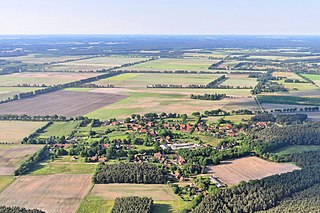
Groß Krams is a municipality in the Ludwigslust-Parchim district, in Mecklenburg-Vorpommern, Germany. It is part of the collective municipality of Hagenow-Land.

Rom is a municipality in the Ludwigslust-Parchim district, in Mecklenburg-Vorpommern, Germany.

The Grand Duchy of Mecklenburg Friedrich-Franz Railway was the state railway company in Mecklenburg-Schwerin and Mecklenburg-Strelitz. After its second nationalisation in 1890 up to the merger of the Länderbahnen into the Deutsche Reichsbahn in 1920 it was under the direction of the Grand Duchy's Executive Railway Board in Schwerin.

The Hagenow–Schwerin railway is a double track electrified mainline railway in the German state of Mecklenburg-Vorpommern. It is the second oldest railway in Mecklenburg after the Berlin-Hamburg railway and one of the oldest railways in Germany, opened in 1847 by the Mecklenburg Railway Company.
The Ludwigslust–Wismar railway is an electrified railway in the German state of Mecklenburg-Vorpommern. The Ludwigslust–Bad Kleinen section of the line is double track. The line was opened in 1848, by the Mecklenburg Railway Company and is one of the oldest railways in Germany.
The region of Griese Gegend lies in southwestern Mecklenburg in Germany. In the northwest and north the region is bordered by the River Sude, the stream of the Strohkirchener Bach and its continuation as the New Canal. The region's southeastern border runs roughly from the town of Ludwigslust to Dömitz, in the southwest the River Rögnitz forms the boundary of the Griese Gegend from Woosmer to Lübtheen. The region forms a large triangle.

Ludwigslust is a railway station in the town of Ludwigslust in the German state of Mecklenburg-Vorpommern. The station was opened in 1846 and lies on the Berlin–Hamburg Railway, the Ludwigslust–Wismar railway, the Parchim–Ludwigslust railway and the Ludwigslust–Dömitz railway. The station building, platform, engine shed and water tower are heritage-listed.

Ludwigslust-Parchim II – Nordwestmecklenburg II – Landkreis Rostock I is an electoral constituency represented in the Bundestag. It elects one member via first-past-the-post voting. Under the current constituency numbering system, it is designated as constituency 13. It is located in western Mecklenburg-Vorpommern, comprising the eastern parts of the districts of Ludwigslust-Parchim and Nordwestmecklenburg, and the northwestern part of Landkreis Rostock.
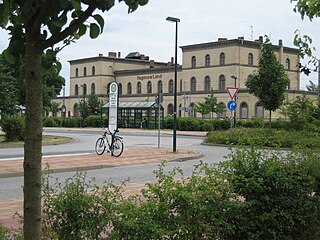
Hagenow Land station is a railway junction in Mecklenburg-Vorpommern, which was opened on 15 October 1846. It is located about 2.5 kilometres from the centre of the small town of Hagenow. It is classified by Deutsche Bahn as a category 5 station.
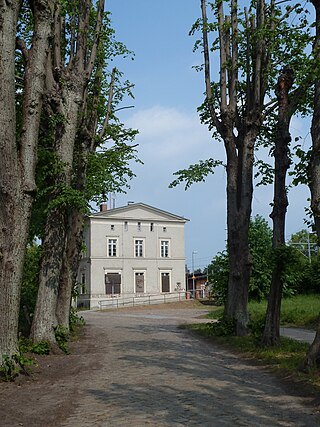
Grabow (Meckl) station is located on the Berlin–Hamburg railway in Grabow in the south west of the German state of Mecklenburg-Vorpommern. Together with four other stations, which also opened on 15 October 1846, it is the oldest station in the state. The Neoclassical entrance building, which dates from the opening of the line, and some other buildings in the station area are heritage-listed.
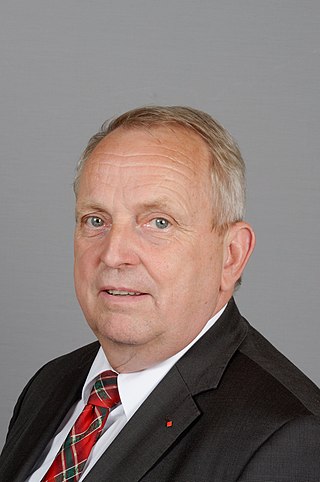
Till Backhaus is a German politician. As the German Democratic Republic approached its end as a standalone state, Backhaus was one of those who in December 1989 (re-)founded the Social Democratic Party, more than four decades after its suppression.
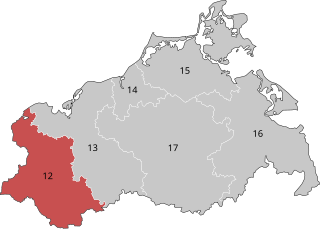
Schwerin – Ludwigslust-Parchim I – Nordwestmecklenburg I is an electoral constituency represented in the Bundestag. It elects one member via first-past-the-post voting. Under the current constituency numbering system, it is designated as constituency 12. It is located in western Mecklenburg-Vorpommern, comprising the city of Schwerin and western parts of the districts of Ludwigslust-Parchim and Nordwestmecklenburg.
























